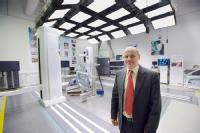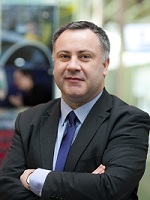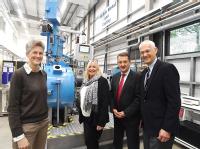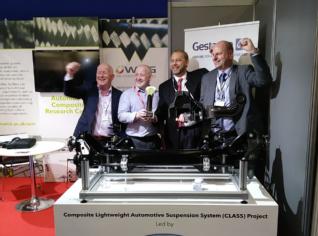WMG News
Car component quality testing technology helps hip surgeons ensure prostheses bind to bones
Hip surgeons are making significant advances in designing hip replacement components using additive manufacturing (3D printing) but have been struggling to devise easy methods of testing the designs they have created without using destructive testing techniques. Now researchers in WMG at the University of Warwick have devised a way of examining and ensuring the quality of those designs without destructive testing using scanning techniques normally used to examine new component designs for high-end automotive manufacturing.
Successful surgical reconstruction or replacement of a joint (arthroplasty) requires integration of the prosthetic implant with the bone to replace the damaged joint. Surgeons therefore seek to use Bone-mimetic biomaterials for implants as their mechanical properties and porous structure can be designed to allow bone ingrowth and help fix the implant.
WMG Professor chairs Royal Academy of Engineering event
 Professor Kerry Kirwan is looking forward to taking part in the fifth Royal Academy of Engineering’s Frontiers of Engineering for Development symposium, which takes place from 29th April to 2nd May.
Professor Kerry Kirwan is looking forward to taking part in the fifth Royal Academy of Engineering’s Frontiers of Engineering for Development symposium, which takes place from 29th April to 2nd May.
The three-day event takes place at the Academy's home, Prince Philip House, in London, UK. Professor Kirwan, who leads our sustainable materials and manufacturing team, will be chairing a session on Frontiers of Engineering for Development: The Circular Economy.
The symposium is part of a series of international, interdisciplinary workshops that aim to facilitate network building, encourage collaborative work and promote international development and cross-disciplinary thinking among the future leaders of engineering from the UK and around the world.
More information on the symposium can be found here.
Award-winning WMG research makes Ford cars lighter and more efficient
Ford cars could be more fuel efficient and environmentally friendly, thanks to a new lightweight rear suspension component, designed by the award-winning Innovate UK project Composite Lightweight Automotive Suspension System (CLASS), involving WMG at the University of Warwick.
Led by Ford Motor Company, in partnership with WMG, Gestamp Chassis and GRM, the CLASS project consortium developed a new tieblade-knuckle for a Ford Class C vehicle, a key element for the car’s rear suspension.
An optimised design and manufacturing process developed by WMG enabled the researchers to replace the car’s current multiple-piece fabricated steel component with a single moulding - making a weight saving in excess of 4.5kg per vehicle, a 35% saving on the current part.
This will result in CO2 savings over the lifetime of the vehicle, and the technology is appropriate for much wider vehicle chassis and body applications.
In March 2018, the CLASS project won a JEC Innovation Award, in the Automotive Innovation category.
Researchers at WMG carried out materials selection by moulding test plaques and measuring material performance characteristics. This was fed into the design of the part, carried out by Gestamp, before optimisation of the design, carried out by GRM.
Professor Tony McNally selected as overseas expert
 We are proud to announce that Professor Tony McNally has been selected by China’s Ministry of Education and State Administration of Foreign Experts Affairs under Plan 111 as a Foreign Expert to advise in the manufacture and characterisation of functional composite materials.
We are proud to announce that Professor Tony McNally has been selected by China’s Ministry of Education and State Administration of Foreign Experts Affairs under Plan 111 as a Foreign Expert to advise in the manufacture and characterisation of functional composite materials.
China’s Plan 111 is jointly organised by the Ministry of Education and State Administration of Foreign Experts Affairs, P.R. China. It aims to gather groups of first-class minds from around the world to work with leading Chinese researchers on the creation of 100 dedicated innovation centres.
Over the next 5 years Professor McNally will be working in collaboration with the International Innovation Centre for Advanced Manufacturing proposed by the School of Mechanical and Electrical Engineering, Beijing University of Chemical Technology (BUCT).
Professor Tony McNally announced as Editor-in-Chief of new Functional Composite Materials journal
 Professor Tony McNally, who heads up Nanocomposites research at WMG has been announced as the first Editor-in-Chief of the newly formed journal, Functional Composite Materials.
Professor Tony McNally, who heads up Nanocomposites research at WMG has been announced as the first Editor-in-Chief of the newly formed journal, Functional Composite Materials.
The Associate Editors and the Editorial Board, led by Professor McNally, include the leading academics in the field from around the world. The journal will consider contributions on all types of composite materials where composite functionality can be clearly demonstrated.
Functional Composite Materials is published by SpringerNature. The publisher producers a number of key research journals and books globally on science, technology, medicine, humanities and social sciences.
Supporting the steel industry at WMG
 Businesses of all sizes in Coventry and Warwickshire can take advantage of a state-of-the-art facility to develop the next generation of lightweight steel products.
Businesses of all sizes in Coventry and Warwickshire can take advantage of a state-of-the-art facility to develop the next generation of lightweight steel products.
WMG (Warwick Manufacturing Group) at the University of Warwick has created a cutting-edge research, design and skills infrastructure zone in its Advanced Manufacturing and Materials Centre.
Its work is focused on supporting the development of new lightweight steel products as well as building an environment to develop the next generation of experts in this specialist field and can be accessed by SMEs as well as global businesses.
The three-year project has received £1 million of funding from the Government’s Local Growth Fund through the Coventry and Warwickshire Local Enterprise Partnership (CWLEP) to buy key R&D equipment and a further £1 million from WMG which includes industry funding.
Neutron beam from nuclear reactor used to produce safer cars
A partnership led by WMG at the University of Warwick, with the Institut Laue-Langevin (ILL), Tata Steel, and the Engineering and Physical Science Research Council (EPSRC) is using a stream of neutrons from ILL’s nuclear reactor in a new project to examine the safety critical welds in cars made with boron steel.
Press-hardened boron steel is an ultra high-strength steel used across a variety of industries, with a particularly important application in the automotive industry. A large proportion of car manufacturers use boron steel for structural components and anti-intrusion systems in automobiles, as it provides high strength and weight-saving potential, allowing for stronger yet lighter cars, with increased passenger safety.
In the automotive industry, a major joining method for boron steel components is “resistance spot welding”, with several thousand welds being made on a single car. Spot welding exposes the boron steel sheet directly underneath the electrodes” to very high temperatures, causing the metal to exceed melting temperature and then rapidly solidify upon cooling. This results in a heat-affected zone, where surrounding material contracts and its microstructures are altered.
Lightweight steel production breakthrough: brittle phases controlled
Dr Alireza Rahnama has developed a new processing route which allows low density steel-based alloys to be produced with maximum strength, whilst remaining durable and flexible– something which has been largely impossible until now.
Two lightweight steels were tested - Fe-15Mn-10Al-0.8C-5Ni and Fe-15Mn-10Al-0.8C – for their potential to achieve maximum strength and ductility.
During production, two brittle phases can occur in these steels: kappa-carbide (k-carbide) and B2 intermetallic – which make the steels hard but limits their ductility, so they are difficult to roll.
World's 'first named dinosaur' reveals new teeth with scanning tech
 Pioneering technology has shed fresh light on the world’s first scientifically-described dinosaur fossil – over 200 years after it was first discovered - thanks to research by WMG at the University of Warwick and the University of Oxford’s Museum of Natural History.
Pioneering technology has shed fresh light on the world’s first scientifically-described dinosaur fossil – over 200 years after it was first discovered - thanks to research by WMG at the University of Warwick and the University of Oxford’s Museum of Natural History.
Professor Mark Williams at WMG has revealed five previously unseen teeth in the jawbone of the Megalosaurus – and that historical repairs on the fossil may have been less extensive than previously thought.
Institute of Corrosion award presented to WMG’s Dr Michael Auinger
 Dr Auinger’s paper entitled ‘Grain boundary oxidation in iron-based alloys investigated by O enriched water vapour – The effect of mixed oxides in binary and ternary systems,’ has been awarded the TP Hoar Award 2016, by the Institute of Corrosion.
Dr Auinger’s paper entitled ‘Grain boundary oxidation in iron-based alloys investigated by O enriched water vapour – The effect of mixed oxides in binary and ternary systems,’ has been awarded the TP Hoar Award 2016, by the Institute of Corrosion.
The award takes its name from Dr Hoar who was the first recipient of the UR Evans Award – the premier scientific award of the Institute of Corrosion. The TP Hoar Award essentially recognises the Best Paper in Corrosion Science amongst engineers and scientists in steels processing.
This award marks a very successful period for Dr Auinger. In September he also received recognition from the European Optical Society (EOS), scooping the prestigious Best Paper Prize 2014-2015.

